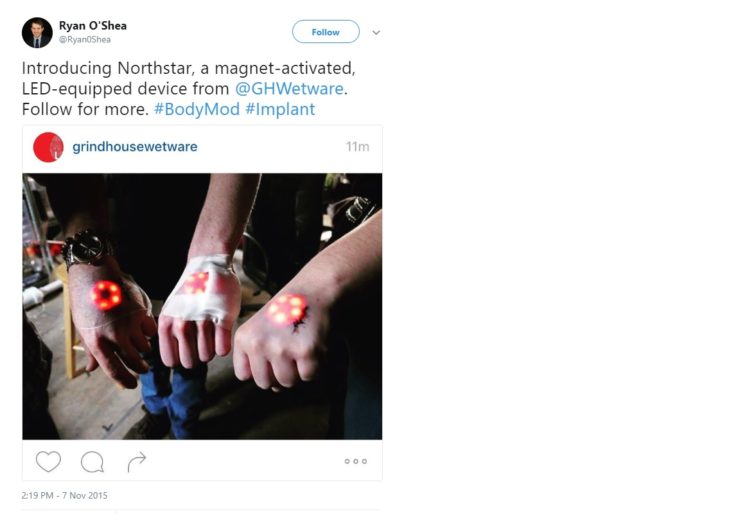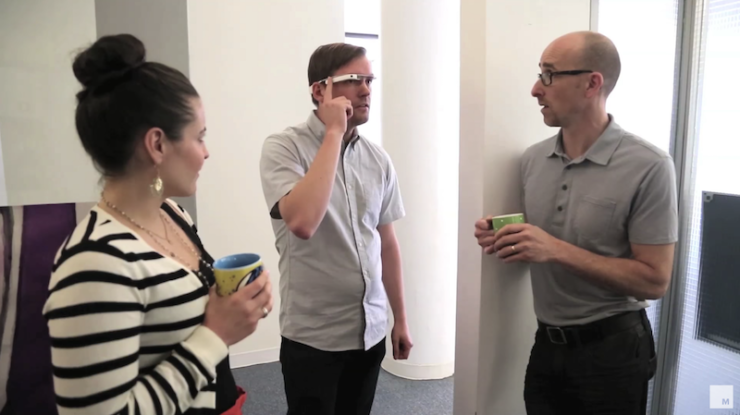Felicio de Costa arrives at the front door and holds his hand against it to gain entry. Inside he does the same thing to get into the office space he rents, and he can also wave his hand to operate the photocopier.
Thus begins a blink-and-you’ll-miss-it January 2015 BBC News story on Epicenter, a high-tech office in Sweden that invited its employees to get “chipped”—to insert RFID (radio-frequency identification) microchips into their hands—as a way to streamline their daily activities. Epicenter’s actions are a mainstream emergence of “group chipping,” just one of the bodyhacking initiatives from the grinder community: people who focus on merging present-day technology with the human body. In our information-rich society, hacking the body in even small ways allows a person to more seamlessly interact with the machines and mechanisms that support us in life: doors, locks, computers—the Internet of Things.
Thirty years ago, this story was fiction.
In William Gibson’s 1984 novel Neuromancer, considered by most to be the harbinger of the cyberpunk genre, hacker Case “jacks in” to cyberspace by slotting a tiny “microsoft” chip into the space behind his ear. The microsoft is such a small part of Case biologically—it would probably be lost if it got flicked onto the floor—yet it defines his identity more completely than if he had a cybernetic limb. The “shared hallucination” of cyberspace is Case’s playground, his income source, the thing he could never live without. And all it takes is one chip to bridge his physical form to a space where he is defined by his intelligence, creativity, and skill with computer code.
Case is only one point on the wide spectrum of bodyhacking depicted in Neuromancer: Molly Millions’ body has been enhanced by the aforementioned cybernetic implants, from razor nails to optical implants feeding her a constant stream of information on her surroundings and other people. Where Case flits between the real and the virtual, Molly prefers to have the virtual contained within her body. Dixie Flatline, formerly known as “console cowboy” McCoy Pauley, is directed towards the opposite: manifesting his self entirely within the virtual realm. Before the death of his body, Pauley/Flatline has his consciousness uploaded onto a ROM. The experience is appropriately jarring. At first, this digital Flatline construct isn’t even aware that he’s not a corporeal being; realizing that, despite the unique knowledge and idiosyncrasies carried over from being Pauley, Flatline’s identity has become unalterably changed in the process of moving from flesh to data. Despite the different forms they take, each of these characters utilizes bodyhacking (or has it used on them) to close the gap between themselves and the identity they want. Or at least, the identity they think they want.
I got my first noticeable piercings at age 23—a nose ring and several hoops and barbells punching the cartilage of each ear. The piercing salon doubled as a tattoo parlor, and though I watched fellow patrons getting inked, I could never envision myself going under that needle—mostly because I didn’t have one particular visual or word(s) that I was comfortable wearing permanently. That’s why I overcompensated with so many piercings, I told people: I wanted something that I could take out if I wanted to, but that nonetheless transformed me.
As I’ve been delving into the world of bodyhacking and its gateway practice of chipping people, I feel that same stirring for something that seems to bridge the gap between piercings and tattoos. Despite the fact that removing an RFID chip is more complicated than taking out a piece of jewelry, it’s not permanent. Here is this tiny device that, held in your hand, may look interesting but can’t do much; but insert it under your skin and both it and you take on new meaning, new purpose. Because getting chipped goes beyond just personalizing yourself, the way that piercings and tattoos do; it also grants you significant and unprecedented control over your identity.
And yet, I keep feeling like I need to shake myself out of what still feels like crazy, science-fiction thinking: It’s one thing to put a piece of metal in my ear, but a chip in my hand? Would I make the leap to computerized contacts that let me see the world like Molly Millions? Would I want the Internet in my brain like M.T. Anderson’s Feed, or is that letting in too many voices and pieces of technology? As much as I feel compelled to go to the next BodyHacking Con and hold out my hand to the grinders performing implants, part of me is scared that doing so will cross a threshold I’m not ready to pass through. At 23, I felt self-conscious getting the most “conventional” piercings in my ears and nose; at 27, I question whether I would call myself a cyborg and participate in the grinder community, or if I just want a cool device that makes me feel special.

There are more hardcore bodyhackers who have test-driven digital tattoos and pills with embedded sensors that track body functions. As I’ve learned more about bodyhacking, I’ve come to see the individualized ways in which its proponents can fine-tune their bodies. Take Neil Harbisson, one of the most prominent figures in the bodyhacking movement and co-founder of the Cyborg Foundation. This colorblind artist persuaded a doctor to implant a camera in the back of his head that allows him to perceive colors through musical notes, circumventing his visual limitations. But it has also distanced him from his fellow humans; in his keynote speech at the 2016 BodyHacking Con, he said that he no longer identifies as human, but as a “cybernetic organism.”
Harbisson hacked himself to overcome a limitation of his physical body, and found that his consideration of his self changed as a result. Other proponents of bodyhacking, like Hannes Sjoblad of the Swedish Biohacking Group, state that part of their self-experimentation is to prepare themselves for the day when the government—or Facebook—wants to chip people. If Sjoblad is correct and such large-scale bodyhacking is inevitable, then a shift in how humanity thinks of itself seems equally inevitable. One generation ago, this kind of tale was relegated to a paperback thriller you could buy in an airport. How did we get here?
The “cyber” half of the “cyberpunk” portmanteau seems the strongest inspiration for today’s grinders, but it’s actually the “punk” half that provides the most motivation. While cyberpunk fiction concretely established the archetype of the cyborg in pop culture, it also gave us the hacker—an antihero, a literal way in to the digital, futuristic world, someone whose ethos we seek to emulate and someone who knows how to manipulate the system that controls their life. Biohackers adopt the attitudes of hackers to turn us into not the mechanical cyborgs of fiction, but into a more biological hybrid. Hackers are the “punks” that anchor the genre (and later spawned a number of other -punks): brilliant, resourceful outcasts and outlaws who can find a way into any digital space.

Digital spaces arrived in earnest in the 1990s, and hackers have persisted as a subculture not because the average hacker finds themselves motivated by heightened, life-or-death stakes, but because of a need to expand their mental capabilities. According to computer programmer and software freedom activist Richard Stallman in the early 2000s, hacking is built on the notion of “playful cleverness” and is less about the action itself than the manner in which it was done—i.e., in the spirit of exploration, of bypassing limitations, of using an object in a novel way unrelated to its intended purpose. (One of Stallman’s favorite examples of a “hack” was using six chopsticks instead of two.) Computer/code hacking is an even more thrilling pursuit in this context: A hacker can physically change the world depending on how well they write.
In parallel to the growth of computers and information networks in the 1990s and beyond, the idea of implanting a machine into your body moved from the realm of fiction into common medical practice. A patient who had never even touched a computer could nonetheless find themselves being offered a machine to regulate their heartbeat. A woman could take automate her fertility cycle by requesting the implantation of a chemical-releasing chip. An amputee would be given an array of options in regards to artificial limbs. It isn’t common to think of patients who partake of these life-saving and life-enhancing services as cyborgs, but by definition these users are no less cyborgs than the chipped hand-wavers. The bodyhacking we are familiar with today is borne of both creativity and necessity.
How we view bodyhacking has followed how the practice has classically been depicted in fiction. Most of the aforementioned implants are nearly invisible, as bodyhacks that more radically alter a person’s appearance seem to instill a sense of revulsion in others. This results in figurative and (in some cases) physical pushback. When Google Glass was at its height, from about 2012 to 2014, several people reported being assaulted for wearing the glasses out in public. While fear of being recorded was suggested as a motive for the assaults, the Google Glass users were also scornfully referred to as “Glassholes”—a value judgment on their decision to enhance part of their body. These people had their Google Glasses ripped off their faces; and Harbisson himself has said that people have attempted to yank off his antenna, despite it being anchored to him internally. This reaction isn’t so different from the outwardly presenting bodyhackers described in Neal Stephenson’s Snow Crash. In the book, Metaverse users who want to be so “plugged in” to their virtual reality that they walk around wearing portable terminals and goggles, are called “gargoyles.”
But even with that opposition, bodyhacking is not something that we consider outlandish anymore. In fact, it’s an area of consumer technology in which we increasingly demand progress. It could be argued that one reason Google Glass failed was not because it was too futuristic, but rather because it was a step backwards. We don’t want to see a website through a clunky headset/glasses hybrid—we want to blink it up onto our cornea like Molly Millions traversing William Gibson’s future. We’re ready for that interface to become internal, to become second-nature.
More and more people are self-identifying as cyborgs, but they’re not the mercenaries or street samurai of fiction, they’re average people who are interested in developing a fine-tuned control of their own bodies and minds. Some experiment with RFID, and some focus on neurohacking, the DIY form of neuroengineering, the goals of which include augmenting intelligence or abilities, preventing disease, and maintaining optimal mental health. Future applications of neurohacking (on the more sci-fi end of the spectrum) would include information retrieval from the brain… though you could argue that our daily use of mnemonics and other memory tricks already fall under the same umbrella.
Cyberpunk was the genre that launched dozens of others: steampunk, silkpunk, dieselpunk, biopunk, etc. But hacking possesses at least as many derivatives: bodyhacking, neurohacking—hell, even lifehacking embodies the hacker ethos. Combine that playful cleverness, that desire to customize our meat constructs, to use our bodies in new and unexpected ways, and you can see why there are people lining up at bodyhacking conventions to implant RFID chips into their hands. We’re pushing into the future we imagined thirty years ago, and we’re almost there.
Natalie Zutter is simultaneously terrified and thrilled by how much she wants to get an RFID chip now. Tweet at her about cyberpunk and whatever new and innovative hacks she hasn’t heard of yet.











I ask this question earnestly, not as an implicit judgment: what distinguishes certain forms of body hacking from self-mutilation? (I’m completely ignorant of the bodyhacking movement).
In brief? Intent.
If you’re hurting yourself for the purpose of harm, that’s self-mutilation. If it’s for decoration, it’s the same spectrum as ear piercing. If it’s for stranger things like “being able to feel electro-magnetic fields in my fingers” then it’s body hacking.
It’s odd but I think I would be a lot more comfortable with an implant or other physical tech solution to neuroengineering than I am with Cognitive Behavioral Therapy or other directed mental exercise. The latter seems like cheating or impermanent or inauthentic. Though a brain control chip or something would be cheating and inauthentic though mostly permanent. It just seems more upfront and maybe like less work overall.
So I guess biohacking is a bit too early days for me (RFID chip in my hand? Um, why?). But if it becomes possible to think with machines rather than just remember them, I might sign up.
I think the same way about ‘body hacking’ that I do about tattoos. Permanence isn’t a great feature at this point. Wearing devices on the body or in clothing is fine, but I don’t want to start cutting the body and inserting devices. It’s one thing to use this as a therapy for health conditions, but I don’t see the point in doing it for convenience or fun.
I guess that my hang-up with bodyhacking is tied into the whole notion of an “Internet of Things” and the sad realization that if I join, then I am a ‘thing’. I do not mind using things, but I do find myself shying off becoming a ‘thing’.
Two comments on this: body modification was one aspect of Delany’s Babel-17 that fascinated me, along with the language – Babel-17 – that eradicated the sense of self through not permitting a first person pronoun.
And i personally do worry about the control possibilities of this:
ht tp://pandora.nla.gov.au/pan/10063/20120504-0022/www.antisf.com.au/the-stories/free-air-for-sale.html